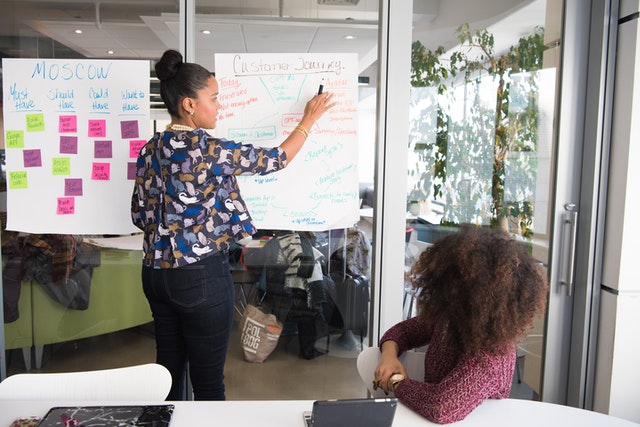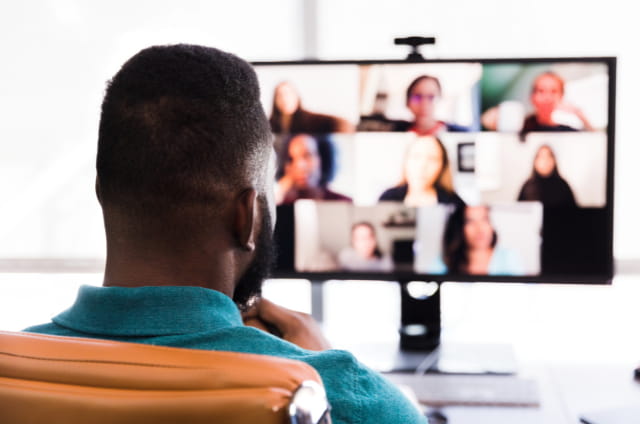How to Keep Calm During a Presentation | 12 Ways
 Chloe Martin
·
5 minute read
Chloe Martin
·
5 minute read
Regardless of the size of an audience, presenting in front of people isn’t easy.
Even household-name business leaders get stage fright.
To help you knock it out of the park next time, we've got tips and tricks that will help you keep calm during a presentation.
12 Ways to Keep Calm During a Presentation
- Practise Out Loud
- Arrive Early and Adjust to Your Surroundings
- Attend Other Presentations
- Meet and Greet
- Engage Your Audience
- Adopt a Power Stance
- Think Positively
- Stay Hydrated
- Smile and Take Deep Breaths
- Don’t Try to Be Perfect
- Silence Isn’t Awkward
- Don't Rush the Ending
Practise Out Loud
It’s natural to want to rehearse your presentation a few times rather than try to wing it on the day, so spare some time to run through your presentation a few times. Although, don’t fixate on trying to remember everything word-for-word like a script. Instead, remember some keywords so you know which direction the presentation will go in rather than sounding robotic.
When practising, don’t just focus on the words you say. Also practise your movement, your pauses, how you’d move across the stage and if you can, record yourself. You’ll get a good feel of how people will see you when it’s the big day. By looking back at your rehearsals, you can make any tiny adjustments to make sure you’re prepared for your presentation.
Arrive Early and Adjust to Your Surroundings
It’s always a good idea to arrive with plenty of time to spare so you can settle in and do some final preparations. You can rehearse some more and adapt to the presentation space. The more adjusted to your environment you are, the more comfortable you’ll feel.
Attend Other Presentations
If you have some spare time before your presentation, watch other presentations before yours to see how others deliver theirs. Not only does it show respect for fellow presenters but it also gives you a chance to feel out the audience. Are they in the mood to laugh or not?
However they feel, you can use that to strategically change your approach to get the reaction you hope for. If your presentation isn’t for quite a while, there’s no harm in attending an event either to pick up on some tips that will help you.
Meet and Greet
If you can, do your best to chat with people before your presentation. It’s a good way to put names to faces and makes you come across as more likeable, friendly and approachable. When you’re in front of the audience and it’s time to present, you’ll be glad that you took the time to speak to people as not everyone in attendance will be a stranger.
Engage Your Audience
During your presentation, try to keep your audience engaged. Maintain eye contact, pace yourself and ask them questions or have them participate in an activity. When you go from monologue to dialogue, it’ll help reduce your nerves and will have the audience hooked on your words and actions.
A good way to do this is by asking the audience if they have any questions, or reiterate that you can stop at any time if somebody wants to ask something. This gives you a nice little break and the engagement between yourself and the attendee can boost your confidence a little more.
Everyone wants to start their presentation with power, here are some of the most impactful ways to start a presentation.
Adopt a Power Stance
Body language is vital during a presentation. Practise confident body language to get rid of those pre-presentation jitters. When you physically demonstrate confidence, your mind will listen. Practise it and make sure you use it during the presentation to create a lasting sense of assurance and confidence throughout.
Try not to curl up or seem smaller than you are. Hold your head high, smile and breathe. You’re in control of the presentation so ooze confidence by maintaining an open posture. That way, the audience knows you command attention.
Body language is VERY important when it comes to communicating the message you want. Here are some body language examples and how you can implement them in the workplace.
Think Positively
It’s human nature to think of the worst-case scenario right away. Try not to get yourself worked up by wondering what people will think of your presentation or if they’ll notice your nerves. Having those feelings isn't a bad thing as it shows you care about doing well. Take all that nervous energy, harness it and turn it into positive enthusiasm and you’ll be just fine.
Stay Hydrated
What’s a big cause of anxiety? A dry mouth. Before and during your presentation, make sure to drink enough water to stay hydrated and avoid a dry mouth. There’s no harm in keeping a glass of water in arm’s reach when you’re presenting, especially if you’ll talk a lot during your presentation. Better safe than sorry.
Smile and Take Deep Breaths
Smiling increases endorphins to replace anxiety with calmness. The result? You’ll feel a lot better about your presentation. It shows a lot of confidence, enthusiasm and that you’re happy to be there. Obviously, don’t overdo it so it looks manufactured. Just be yourself!
It might be the go-to advice for nerves but there’s a reason for it. When we’re nervous, our muscles tighten so it’s natural to hold our breath. When you feel that way, just take some deep breaths to get oxygen to your brain and relax your body.
Don’t Try to Be Perfect
The most memorable presentations are the ones that are engaging and don’t seem like they’ve been rehearsed down to a tee. You’ll find that trying to make every second of your presentation perfect is going to make you more nervous as you won’t know how to react if the unexpected happens.
Don’t let a mistake slow you down. Try not to speak as if you’re reading from a script. If there’s something wrong with the screen or a tiny mistake, make a joke of it and move on. These things are bound to happen and it shows the attendees you’re human, like them. Your audience will actually appreciate seeing the real you rather than forcing your presentation and acting too much.
Silence Isn’t Awkward
Don’t feel like you need to fill up every second you have. Think of some of the best speakers around from the late Steve Jobs to Bill Gates. Whichever example you research, you’ll find they don’t rattle on and on. Instead, they utilise that silence to their advantage which is something you should do as well.
Use it as an instrument to create some tension, excitement, impatience and get the audience on the edge of their seats. The silence is valuable as it gives you time to refocus, drink some water, take those deep breaths and give your audience time to digest your talking points.
Got a remote presentation coming up? Learn how to use your body language to show confidence.
Don’t Rush the Ending
Don’t abruptly end your presentation and run off as soon as you can. Maintain the breathing, smiling and power stance while also making it crystal clear that your presentation has come to an end. Even if it’s in a few words, it can do the trick. It also gives the audience a chance to ask questions and even give you a round of applause to show their appreciation.
When you get that round of applause, it’ll calm you down even more.
Discover 7 of the most powerful ways to end a presentation.
The nerves before and during a presentation often boil down to a lack of confidence and how to communicate with an audience properly. If that sounds like you and an area you want to improve on, we’ve got a useful handbook you can download.
Improve Your Communication Skills With Our Handbook
Whether you need to work on your presenting skills or you want to improve internal communication, our handbook covers the essential information you need and some tips to try out right away.
To get your free copy, click on the link below.








